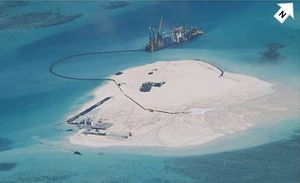China’s Defense Ministry has openly criticized the United States over its South China Sea policy accusing the U.S. of “activities to militarize the South China Sea region,” defense ministry spokesperson Yang Yujun said during a press conference on July 30.
He also accused U.S. officials of “making irresponsible remarks on the South China Sea issue” and applying “double standards” when it comes to assessing their own activities in the region.
“The U.S. side disregards and distorts the fact, and plays up ‘China’s military threat’ to sow discords between China and China’s maritime neighbors in the South China Sea. We firmly oppose such actions,” Yang emphasized.
The spokesperson also accused the U.S. of not openly speaking out against construction activities of other claimants such as the Philippines or Vietnam, despite U.S. Defense Secretary’s remarks at this year’s Shangri-Law Dialogue that “there should be an immediate and lasting halt to land reclamation by all claimants.”
While “the U.S. side has remained silent on the massive construction activities conducted by some countries such as the Philippines on the illegally occupied Chinese islands and reefs,” Yang said, “the U.S. made irresponsible accusations against China on the legal activities of China on its own territory.”
The defense ministry cites as evidence for U.S. militarization activities U.S. patrols through waters that China claims as its own: “[T]he U.S. side has been sending ships and planes to conduct frequent close-in reconnaissance activities against China in the South China Sea region.”
China cited as further evidence joint military exercises that the United States is conducting with its allies in the region (See: “Australia and US Conclude Major Military Exercise in Pacific Region”).
Nevertheless, Yang in particular expressed his discontent with Admiral Scott Swift, who assumed command of the U.S. Pacific Fleet in May of this year, and his decision to join a seven-hour maritime surveillance mission on board a P-8A Poseidon over the South China Sea:
The commander of the U.S. Pacific Fleet even cruised over the South China Sea on a plane, creating tensions in the region and increasing the risk of unexpected incidents in the air space and maritime area of the region. The Chinese side expresses its serious concern on the U.S. activities to militarize the South China Sea region. And such actions taken by the U.S. side would inevitably arouse the question from others — does the U.S. want nothing but chaos in the region?
This Wednesday, the commander of Japan’s Maritime Self-Defense Forces (JMSDF), Admiral Tomohisa Takei, also warned in a speech delivered at the Carnegie Endowment for International Peace in Washington, D.C. that should China use the artificial islands it has built for military purposes, all of the South China Sea could be “covered by China’s sphere of military influence” (See: “Head of Japan’s Navy Warns of Beijing’s Militarization of South China Sea”).

































